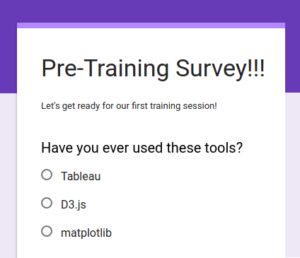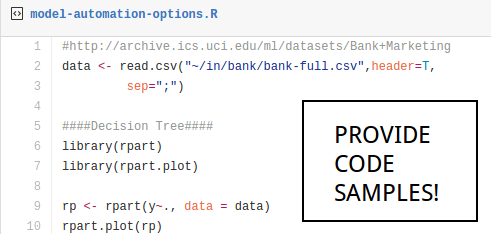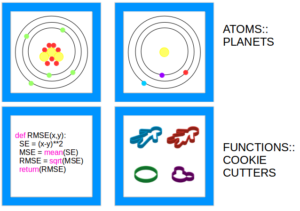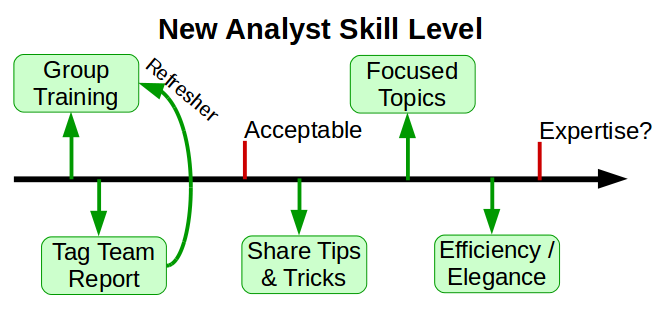Summary: The best training sessions gather information on the audience before and after by using a survey. There are no surprises in the class because handouts detail everything that is taught. Lastly, analogies are used and students participate in order to cement the knowledge.
When you know something that is important and you work at a large company, you invariably will have to train someone else to know what you do. Whether it’s for backing you up, for building a new team, or maybe your company promotes cross-learning you are responsible for other people’s development.
I have had to do dozens of training sessions on technical (R, SAS, SQL) or business domain knowledge topics. Here are the core concepts I have learned that helps the students retain what they learn.
Pre and Post Surveys

How do you train someone when you have no idea about their background? The simplest thing you can do is prepare yourself to teach by getting a baseline of what your student(s) already know.
A pre-training-survey should cover the topics of the training session. The survey should essentially be the syllabus. There should be no surprises in the training!
The questions should be open ended to help show thought process: “How would you query for customers who used an incentive in the past 12 months?”
But there’s room for multiple choice questions: “Which R function provides a five number summary?”
The post-training-survey should have the exact same questions so that you can judge whether or not they learned anything. Those who seem to get the same questions wrong may need some additional follow-ups.
Handouts Are Critical

There are training sessions that stick with you and there are sessions that slip right out of your memory. A handout helps in every situation. If you are training multiple analysts, everyone is following along at their own pace. It is extremely helpful, for the trainee, to be able to take a moment and look down at their handout and reason it out for themself.
Ideally, you would want to be able to stop and explain everything. However, with time limited, a handout lets you provide more context or greater details.
Whether you choose PowerPoint slides with space for notes or annotated code snippets, providing something is better than nothing.
I have given presentations on Model Automation in R and on building a recommender system with pyspark. Each time, I provided a copy of the code (and made them available with a gist from github) for people to follow along. The number one comment after the presentation has always been “Thank you for printing out the code! It made it a lot easier to follow.”
Build Bridges to Related Concepts

The book A Mind for Numbers and the MOOC Learning How to Learn provide a great deal of research on the way you can truly learn a topic. The core concept relies on building relationships between new material and existing knowledge.
For example we all know that the electrons of an atom orbit around the nucleus… however, that’s not really true. Electrons exist in a probability cloud rather than in a discrete pattern. However, someone just learning about atomic structure needs a bridge between something they know and the new material.
Take learning to use Spark RDD’s. A normal analyst likely knows SQL so when introducing Spark explain the similarities and differences.
- SQL is a declarative language. You say what you want and the SQL engine figures out the rest.
- Spark, instead requires you to tell it what to do every step of the way.
Same could be said for learning about machine learning algorithms.
- Decison trees break partition the data at each split. It would be like doing a temp table in SQL and then running the algorithm on that new temp table.
Using the pre-survey you should be able to ask about previous tools and experiences to help you build a bank of analogies. Oregon State has a comprehensive article on the importance of analogies in teaching science.
Get Hands On and Encourage Discussion
Listening to someone talk about a technology is a lot less exciting than actually working through the problem and using the tools. Periodically, you need to hand over the keyboard and let the trainees drive.
I am a big believer in asking the audience to figure something out. Especially if it generates a discussion among the trainees. There is no substitute for learning from your peers. It encourages analysts to not be dependent on one person and it can help solidify concepts.
Even if you’re one of the best teachers, your audience may not be paying attention to you but when it’s one of their own speaking they tend to listen more closely.
Offer Continued Support

Your training session is done! Your post-survey is complete. They’re on their own now… Not quite yet.
Offering continued support provides sustained learning. The adage “If you don’t use it, you lose it” is painfully true when it comes to technology. In order to prevent your students from forgetting everything, consider a few methods for keeping things fresh.
- Quick one-on-one follow-ups for specialized topics.
- Allow past students to sit in on recent training sessions.
- Collect resources and share them with past students.
- Create periodic “master” classes.
This greatly depends on the emphasis your management puts on these technologies being taught. If you are serious about altering the forgetting curve, you will need to repeatedly test your students.